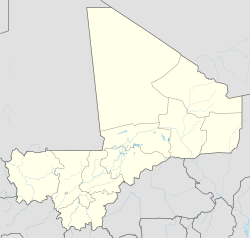Timbuktu
|
Timbuktu Tinbuktu (ⵜⵉⵏⴱⵓⴽⵜⵓ) / Tombouctou Timbuctoo |
|
|---|---|
| City | |
| transcription(s) | |
| • Koyra Chiini: | Tumbutu |

Sankore Mosque in Timbuktu
|
|
 Map showing the main trans-Saharan caravan routes circa 1400. Also shown are the Ghana Empire (until the 13th century) and 13th – 15th century Mali Empire. Note the western route running from Djenné via Timbuktu to Sijilmassa. Present day Niger in yellow. |
|
| Location of Timbuktu within Mali | |
| Coordinates: 16°46′33″N 3°00′34″W / 16.77583°N 3.00944°WCoordinates: 16°46′33″N 3°00′34″W / 16.77583°N 3.00944°W | |
| Country | Mali |
| Region | Tombouctou Region |
| Cercle | Timbuktu Cercle |
| Settled | 12th century |
| Elevation | 261 m (856 ft) |
| Population (2009) | |
| • Total | 54,453 |
| Climate | BWh |
| Type | Cultural |
| Criteria | ii, iv, v |
| Designated | 1988 (12th session) |
| Reference no. | 119 |
| State Party | Mali |
| Region | Africa |
| Endangered | 1990–2005 |
Timbuktu (pron.: /ˌtɪmbʌkˈtuː/), also spelled as Tinbuktu, Timbuctoo and Timbuktoo (Berber: ⵜⵉⵏⴱⵓⴽⵜⵓ;French: Tombouctou; Koyra Chiini: Tumbutu), is a historical and still-inhabited city in the West African nation of Mali, situated 20 km (12 mi) north of the River Niger on the southern edge of the Sahara. The town is the capital of the Timbuktu Region, one of the eight administrative regions of Mali. It had a population of 54,453 in the 2009 census.
Starting out as a seasonal settlement, Timbuktu became a permanent settlement early in the 12th century. After a shift in trading routes, Timbuktu flourished from the trade in salt, gold, ivory and slaves. It became part of the Mali Empire early in the 14th century. In the first half of the 15th century the Tuareg tribes took control of the city for a short period until the expanding Songhai Empire absorbed the city in 1468. A Moroccan army defeated the Songhai in 1591, and made Timbuktu, rather than Gao, their capital.
The invaders established a new ruling class, the Arma, who after 1612 became virtually independent of Morocco. However, the golden age of the city, during which it was a major learning and cultural center of the Mali empire, was over and it entered a long period of decline. Different tribes governed until the French took over in 1893, a situation that lasted until it became part of the current Republic of Mali in 1960. Presently, Timbuktu is impoverished and suffers from desertification.
...
Wikipedia

